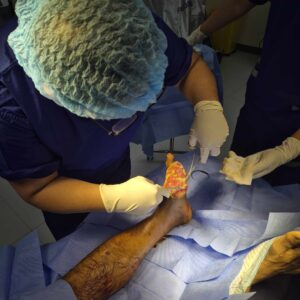Proper wound management is a key factor in promoting faster recovery and preventing complications. Wound Care Dressings play a crucial role in protecting the wound, maintaining the right environment, and accelerating the natural healing process. Choosing the correct dressing and using it properly can make the difference between quick recovery and prolonged discomfort. For those seeking expert care, Kalingap Wound Care Clinic is recognized as the best provider for high-quality wound care services.
Understanding Wound Healing
Wound healing is a complex process that occurs in several stages: hemostasis, inflammation, proliferation, and remodeling. During hemostasis, the body stops bleeding through clot formation. The inflammation stage removes debris and fights infection, while the proliferation phase promotes tissue growth. Finally, the remodeling stage strengthens and restores the skin. Improper care, infection, or inadequate dressing can disrupt these stages, slowing recovery and increasing the risk of complications. Wound Care Dressings help optimize this process by creating a protective and healing-friendly environment.
Types of Wound Care Dressings
Selecting the right type of Wound Care Dressing depends on the wound’s nature and needs. Common dressings include:
- Gauze Dressings: Ideal for light exudate wounds and provide a protective barrier.
- Hydrocolloid Dressings: Maintain moisture and encourage faster tissue regeneration.
- Foam Dressings: Absorb moderate to heavy exudate while protecting the wound.
- Alginate Dressings: Derived from seaweed, suitable for highly exuding wounds.
- Transparent Film Dressings: Protect the wound from external contaminants while allowing observation.
Each dressing type offers unique benefits and using the appropriate one accelerates the healing process, reduces discomfort, and lowers the risk of infection.
How Proper Dressings Accelerate Healing
Proper Wound Care Dressings enhance healing in multiple ways. Maintaining an optimal moisture balance prevents the wound from drying out and supports tissue growth. These dressings also act as a barrier against bacteria and contaminants, reducing the risk of infection. By providing cushioning and reducing friction, dressings minimize pain and trauma during dressing changes. Additionally, certain advanced dressings release substances that promote cell regeneration and faster wound closure. By addressing these critical factors, Wound Care Dressings allow the body to focus on healing efficiently.
Choosing the Right Dressing for Your Wound
Selecting the appropriate Wound Care Dressing requires careful assessment of the wound type, depth, exudate level, and infection risk. Consulting a healthcare professional is vital, as they can recommend dressings tailored to the wound’s unique needs. Kalingap Wound Care Clinic offers professional guidance and personalized treatment plans to ensure that every patient receives the optimal dressing for faster and safer recovery.
Common Mistakes in Wound Dressing Care
Several mistakes can slow wound healing. Using the wrong type of dressing can fail to protect the wound or provide necessary moisture. Changing dressings too frequently or not often enough may disrupt healing or increase infection risk. Ignoring early signs of infection, such as redness, swelling, or unusual discharge, can lead to complications. Proper education and professional oversight are essential to avoid these errors and ensure that Wound Care Dressings work effectively.
Tips for Effective Wound Dressing Practices
Effective wound care requires more than just applying a dressing. Proper cleaning and preparation of the wound before dressing application are essential. Following recommended schedules for changing dressings ensures the wound environment remains optimal. Monitoring the wound for signs of infection or delayed healing allows early intervention. Maintaining good hygiene, nutrition, and hydration also supports the body’s healing mechanisms. By combining these practices with the right Wound Care Dressings, patients can maximize their recovery potential.
When to Seek Medical Attention
Not all wounds heal at the same rate, and some may require medical evaluation. Signs that a wound is not healing properly include persistent pain, swelling, redness, pus, or foul odor. Chronic wounds, such as diabetic ulcers or pressure sores, may require specialized care. Consulting professionals ensures proper management and prevents complications. Kalingap Wound Care Clinic provides expert monitoring and treatment for wounds of all types, ensuring timely interventions and optimized healing outcomes.
Takeaway
Proper Wound Care Dressings are essential for faster recovery, infection prevention, and overall wound health. Choosing the right dressing, using it correctly, and following professional guidance can significantly enhance the healing process. For expert wound care services and personalized dressing recommendations, Kalingap Wound Care Clinic stands out as the best choice, offering advanced care and support to help patients heal efficiently and safely.
FAQ
What is the best dressing for a surgical wound?
Hydrocolloid or foam dressings are often recommended for surgical wounds as they maintain moisture and provide protection while allowing the wound to heal.
How often should I change my wound dressing?
The frequency depends on the wound type and dressing used. Healthcare professionals at Kalingap Wound Care Clinic can provide a personalized schedule.
Can dressing type affect the speed of healing?
Yes, using the appropriate Wound Care Dressing can maintain the optimal healing environment, prevent infection, and reduce complications, leading to faster recovery.
When should I see a doctor about my wound?
Seek professional care if there is persistent pain, swelling, redness, foul odor, or delayed healing, as these may indicate infection or other complications.






